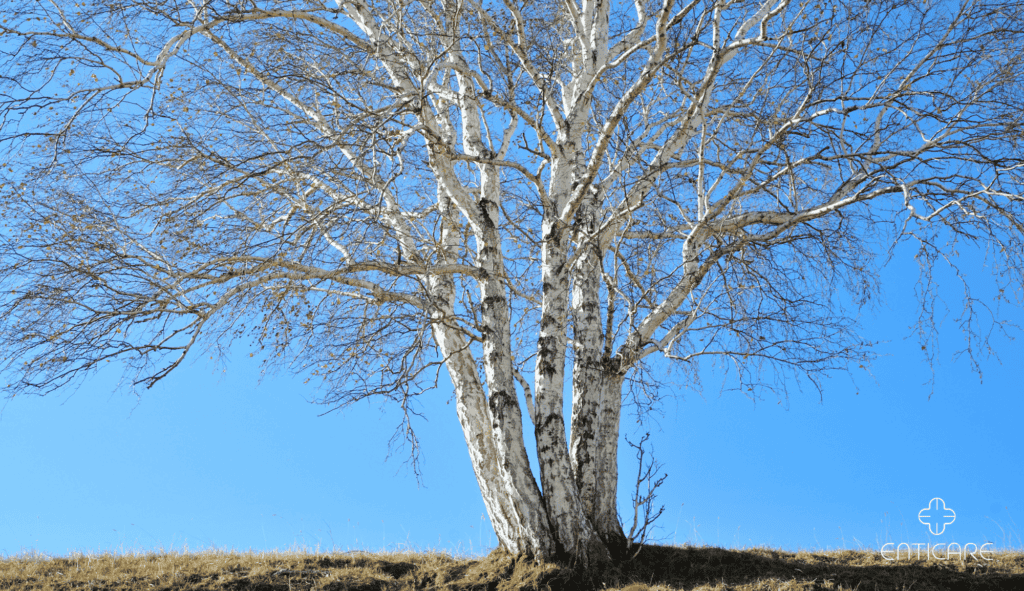The world of allergies can be a complex one, with seemingly innocuous substances triggering uncomfortable and even life-threatening reactions. Among these lesser-known allergens lies the “Birch Tree,” a combination of proteins found in birch pollen and several fruits and vegetables, leading to the development of Birch Tree allergies.
As we unravel the facts surrounding Birch Tree allergies in North America, prepare to gain a comprehensive understanding of this prevalent allergen group that might be influencing your health more than you realize.
Birch Tree allergies might sound esoteric, but they are prevalent and impactful. Originating from the Betulaceae family, the Birch Tree group encompasses a range of allergens that can trigger reactions in unsuspecting individuals. Are you ready to uncover the origins and dive into the complexities of Birch Tree allergies that might be influencing your health?

Pervasive Pollen Presence
Birch trees, known for their distinctive white bark and triangular leaves, release pollen during the spring months in North America. This pollen is a common trigger for seasonal allergic rhinitis, affecting individuals with Birch Tree allergies.
Common Culprits in North America
The Birch Tree allergen group in North America includes a range of trees, with Betula alleghaniensis (yellow birch) and Betula papyrifera (white birch) being prevalent. These trees contribute to the release of birch pollen that can trigger allergies.

Unveiling the Origin and Science
Birch pollen
Birch trees release pollen during spring, which can cause allergic rhinitis (hay fever) in many individuals.
Certain fruits and vegetables
These fruits and vegetables contain proteins with similar structures to those found in birch pollen. When consumed by individuals with Birch Tree allergies, the immune system mistakenly identifies these proteins as threats and triggers an allergic response.
Some examples include:
- Tree fruits: Apple, pear, peach, plum, apricot, cherry
- Stone fruits: Almond, hazelnut, pistachio, walnuts
- Rosacea family: Celery, carrot, fennel, parsley, parsnip, dill
- Other: Kiwi, soybean, peanut (in some cases)
Exploring the Symptoms
Birch Tree allergies can manifest in various ways, often mimicking symptoms of other food allergies. Here are some common signs to watch out for:
Oral allergy syndrome (OAS)
This includes tingling, itching, or swelling of the mouth, lips, tongue, and throat.
Skin reactions
Hives, rashes, or eczema can occur in some individuals.
Digestive issues
Nausea, vomiting, diarrhea, or stomach cramps might be experienced.
Respiratory problems
In severe cases, individuals might experience wheezing, coughing, or difficulty breathing.

Managing Birch Tree Allergies
Living with Birch Tree allergies does not have to limit your quality of life. Here are some effective management strategies:
Strict avoidance
This is the most effective way to prevent allergic reactions. Meticulously check food labels, inform chefs and restaurants about your allergies, and be cautious when consuming unfamiliar foods.
Cooking methods
Cooking might denature certain proteins, reducing their allergenicity in some cases. However, consult your allergist before trying this approach.
Antihistamines
Over-the-counter antihistamines can help alleviate mild allergic symptoms.
Immunotherapy (allergy shots)
In some cases, allergy shots might be recommended by your doctor to desensitize your immune system over time.
While birch pollen allergy testing is readily available, specific tests for Birch Tree allergies might not be widely accessible everywhere in North America. However, consulting an allergist for comprehensive allergy investigation is highly recommended. By understanding these facts, individuals and healthcare professionals in North America can be more aware of Birch Tree allergies, facilitating accurate diagnosis and effective management to improve the lives of those affected. Explore your treatment options with Enticare. Call us at 480-214-9000!

